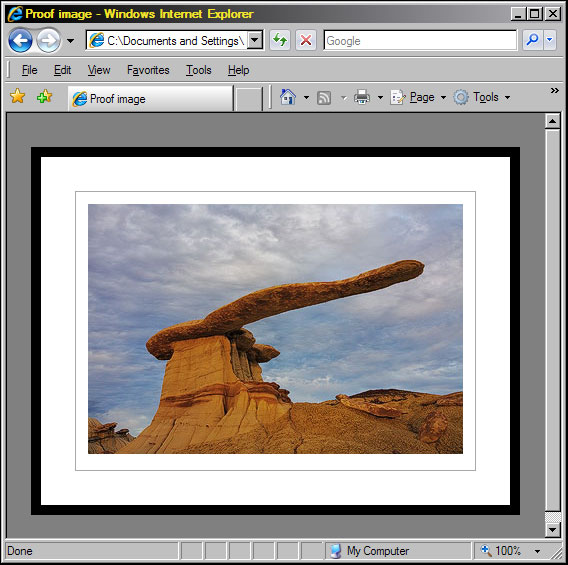e-Framing for Soft-Proofing
©2009 Tony Kuyper
Photoshop is a vast program that offers infinite possibilities. It's so big, in fact, that a common challenge when working in the digital darkroom is deciding where to go with a particular image. Proofing an image outside of Photoshop can often be very helpful in this regard. Seeing the image as a proof allows the photographer to better understand where it is at any given moment during its development and where it needs to go. Proofs are a good way to judge whether a particular Photoshop enhancement is working and to compare the effect of different adjustments.
The ultimate proof is a full-size print on paper that will be used for final printing. However, this can be expensive and time-consuming. The computer's web browser provides a fast, inexpensive alternative. It offers speed and economy, and, while not perfect in its rendering of color, provides a neutral space for viewing an image and making editing decisions.
The basic procedure for soft-proofing is to prepare an image in Photoshop, save it for the web, and then e-mat and e-frame it using HTML code in a browser window. The process creates a natural-looking framed print that improves the photographer's ability to evaluate the image. By using multiple browser windows it's possible to quickly compare different development options for the image by clicking between the various windows.
This newest eBook describes soft-proofing using a web browser and how it can assist the photographer in developing images in Photoshop. Two Photoshop web-sharpening actions ("Less Halos" and "More Contrast") and HTML and text files that are part of the process are included. It's not too hard to set up, and once it's in place can be used over and over with all types of images.
One of the most important elements in making this work is to create an image that is well-sharpened for the web. Figure 1 below is an image that is resized but not sharpened. The rollover shows how much better the image looks once it's sharpened using one of the included web-sharpening actions, in this case the "Less Halos" version.
Figure 1

|
After sharpening, the image is saved and then re-opened in a browser window. HTML code creates a web page that adds a frame and mats to the image giving it a more realistic presentation than can be achieved in Photoshop. Figure 2 shows how the web browser version looks. A section of eBook also discusses how to modify the frame by altering the HTML code. An example of a customized frame can be seen in the rollover of Figure 2.
Figure 2

|
Deciding how to develop an image in Photoshop is sometimes as hard as composing the scene in the field. Soft-proofing an e-framed image in a web browser is a useful method to help make important editing decisions. It provides a more natural presentation space where the photographer can evaluate the image and decide what to do with it in Photoshop. It also allows quick comparison to previous iterations and can point out areas that need attention that might not be obvious inside Photoshop. The PDF eBook describing this process in detail and the associated files and Photoshop actions to make it work are included in the Special Offer .